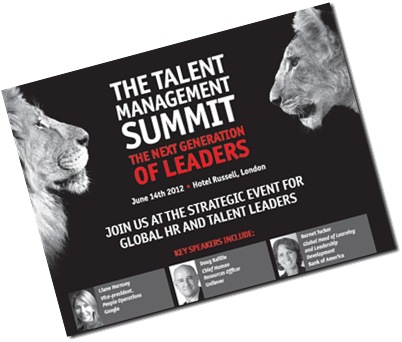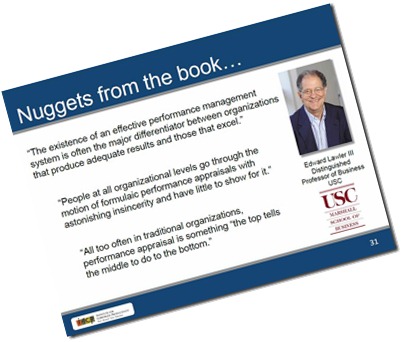 You know I’m a fan of Ed Lawler, right? (see 1,2,3). We’re not talking John Boudreau or Peter Cappelli here (though of course Boudreau is Lawler’s colleague at USC).
You know I’m a fan of Ed Lawler, right? (see 1,2,3). We’re not talking John Boudreau or Peter Cappelli here (though of course Boudreau is Lawler’s colleague at USC).
But I’m afraid I think Lawler’s article in the Executive Guide to Integrated Talent Management (featuring me, Dave Ulrich, Marshall Goldsmith – plus Peter Cappelli etc) has got everything pretty much completely the wrong way round.
It all starts off OK:
“The existence of an effective performance management system is often the major differentiator between organisations that produce adequate results and those that excel. Without a focus on performance management at all levels of an organisation, it is hard to see how an organisation can find a talent-based competitive advantage.
It is far from easy to get performance management right in an organisation. The corporate world is littered with companies whose employees never receive an effective performance appraisal. People at all organisational levels go through the motions of formulaic performance appraisals with astonishing insincerity and have little to show for it. There also are numerous examples of situations where individuals thought they were going the right thing and performing well only to find out that they were mistaken when they had their annual appraisals. Finally, in many organisations, performance appraisals simply aren’t done, either because of employee resistance or because managers ‘dry lab’ (fake) them.”
Agreed. And I think these reasons are why an increasing number of organisations are jettisoning their performance management processes and doing something more innovative and resonant instead.
But if you are going to do it, it’s important to know the best practices which will tend to stack the odds as far in your favour as much as you can.
To me, Lawler’s suggestions are more part of the problem than they are part of the solution. Here’s why:
1. Start at the top
Lawler: “In the best of all possible worlds, goals are first set at the top and then cascaded down so that individuals at each level have goals that are tied to the overall strategic direction of the organisation.”
Me: Well, I understand the logic for this – I’ve even led large projects (£1m+) based upon this principle, and shouted about the case studies which result. But increasingly I see organisations which are just to complicated and complex for this to work. You can’t just start with the top level goals and slice and dice till you end up with every individual taking on their own teeny little bit. Things don’t work like that. So as long as everyone is clear about the overall business strategy, and their own role requirements, they and their managers, and increasingly those other people working around them, are the best people to decide on their goals. Plus of course doing this makes the whole process much quicker and more agile, and less tedious all round.
2. HR should support, not own, the system
Lawler: “HR managers should not act as the conscience of the organisation or drive and sell performance management. These should be the responsibilities of the top managers.”
Me: If HR can’t own this, what can it own? (nothing!). It depends on what you want HR to be – if it’s just an administrative side attraction, then fine, just tell it to operate the logistics of the appraisal round. But if you want HR to drive competitive success but ensuring you have the people you need, you’ve got to give HR ownership of some of the key tools.
Some of this comes down to the difference between accountability and responsibility. HR can’t be responsible for managing peoples’ performance – that’s got to rest with the line. But HR can be accountable for good performance management taking place across the organisation. And owning the system which enables managers to own the performance of the people in their teams is a key part of enabling this to happen.
3. Cascade strategy and goals to all levels
Lawler: “The starting point for an effective performance management process should be the business strategy of the organisation. It should guide a goal-setting process that leads to individuals, teams and business units having transparent goals and objective sthat are directly tied to the strategy of the business. For this to be effective, the goal-setting process needs to begin at the top of the organisation and cascade down.”
Me: I would ignore the fact that this is really just a repeat of Lawler’s principle 1 except that my challenge is largely the same as my earlier one too. Not everything can be dictated from the top. If nothing else, it’s not very compelling to be treated like this ie as a small cog in part of the big organisational wheel. It’s often better to let people come up with objectives they’re going to be committed too, even if they’re not directly aligned with those of the top cheese. See my post on performance leadership for more on this.
4. Set measurable goals
Lawler: “Measurable goals need to be set, and individuals should be assessed in relation to them. This applies to both the skills and competencies that individuals need to develop and also, of course, their performance deliverables – the how and the outcomes of their performance.”
Me: Yeah, measurable’s nice, as it helps understand how people are doing and how much to pay them. But this is about performance assessment, not improvement. And improvement comes, once again, from making goals compelling, not merely measureable. See my earlier post on making objectives MUSICal, not just SMART.
5. Set talent development objectives
Oh good grief – get people to set these themselves. Then they may actually own them and do something about meeting them.
6. Rate outcomes and performance, don’t rank people
Lawler: “Some organisations (for example, ExxonMobil) rank-order hundreds, or in some cases thousands, of people from first to last, numbering them from one to whatever the total number of individuals is in the part of the organisation that is being appraised. This effort is like trying to measure the length of an objective to the closest thousandth of an inch using an ordinary straight ruler; the information needed to measure performance so precisely just isn’t available.”
Me: Yes, but you can’t accurately compare people’s performance at higher levels either. Nobody’s performance, goals or their job is the same, so you’re comparing apples with oranges whatever you try and do. Anyway, it’s not the ‘information’ that’s important here, it’s the conversation. The value of ranking, and why I suggest organisations do it, is the conversations between managers about what they value in different people and why they perceive some as more valuable than others. I’ve never seen the same quality of discussion take place over simply rating people. I4CP can show that it’s apparently less popular, but personally, I’d still do it.
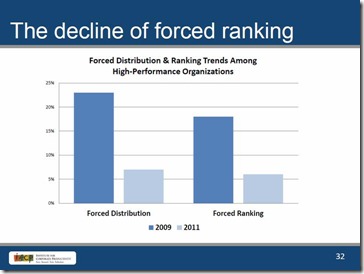
Lawler: “Another seriously flawed rating practice is forced distribution. Some organisations (for example, GE, EDS and Accenture) require their managers to identify a certain proportion of their reports who are failing, often 5 to 10 percent, and a certain proportion who are doing particularly well, often 15 to 20 percent. The forced distribution approach ignores the reality that some work groups have no poor performers and other have no good performers.”
Me: Yes, that’s probably true, though GE never forced this to the extent that the story was spun. Anyway, you get round the problem by rating and ranking people. So they get rated based upon their objectives, and ranked against everyone else. If they’re performed well against their objectives but their colleagues have done even better (ie the bar has been raised) they’ll get a good rating but be ranked rather lower. I can’t see the problem in this.
7. Train managers and employees
I almost have to agree to this one, but there is a way round doing so. Recognise the need for emergence – if you have to train people (on the system, not just having good quality conversations) then the system is too complex. keep the bureaucracy light and just let it happen. Managers and employees will find their own ways to manage and improve their performance.
8. Link rewards to performance, but discuss development separately
Lawler: “Principle 8 is to link rewards to performance, but to discuss development separately. An important feature of an effective performance management system is the degree to which it affects the reward system; in other words, the degree to which it leads to pay increases, bonuses, stock options and promotions. Over the years, articles and books have claimed that performance management processes should separate the appraisal of performance from discussion about salary increases and promotions. This may indeed make some of the discussion easier, but it is not the way to make money and other tangible rewards effective motivators.”
Me: I certainly agree that there’s a problem here – put simply, if money’s involved, people won’t discuss their development needs (weaknesses) because they think it’s going to result in them being paid less. So they pretend they don’t have any needs, only strengths, so no, or at least less, development needs get identified. But I think Lawler is completely wrong to go with the reward vs the development aspect. Firstly because we know reward doesn’t motivate that much. And secondly, because it definitely doesn’t improve performance (by very much).
So use performance management to drive learning and development – both key drivers of improvement in any organsiation. And figure out something else (like this) to provide a basis for reward.
9. Appraise the appraisers
Again, a bit more of a difficult one to object too, but it’d be a shame to give up now…. so of course I need to note that simply appraising managers isn’t really going to be anything like enough. More important is finding people to work as managers who are motivated and competent to manage. And then you won’t have to worry about appraising them.
10. Consider having review discussions online
For a while I thought this would be the hardest principle of the ten to challenge – but then I saw my way through it. Don’t consider – just do it! This isn’t so much for the sake of being more ‘functional’ (“it gives individuals a chance to think a bit before they make their responses”) however, as Lawler suggests – it’s because online provides better clarity, sharing and memory than doing it any other way. Simps.
There you go – sorry Ed!
Also see
- Consulting - Research - Speaking - Training - Writing
- Strategy - Talent - Engagement - Change and OD
- Contact me to create more value for your business
- jon [dot] ingham [at] strategic [dash] hcm [dot] com
.
 June tomorrow and only a couple of weeks to the Economist Talent Management conference on the 14th where I will acting as a media partner (ie I’ll be blogging a lot) and moderator (interviewing Ryan Blair).
June tomorrow and only a couple of weeks to the Economist Talent Management conference on the 14th where I will acting as a media partner (ie I’ll be blogging a lot) and moderator (interviewing Ryan Blair).




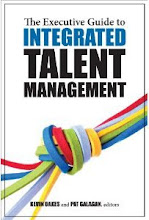



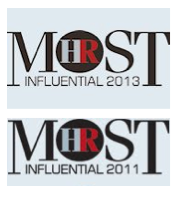







 I recently chaired a panel on customer centricity: 'Internal v External - promoting innovation in HR to build a consistent leadership brand'.
I recently chaired a panel on customer centricity: 'Internal v External - promoting innovation in HR to build a consistent leadership brand'. There was some interesting research out a few weeks ago from Epson and CEBR suggesting that the average UK office worker wastes 2 hours and 39 minutes in meetings every week.
There was some interesting research out a few weeks ago from Epson and CEBR suggesting that the average UK office worker wastes 2 hours and 39 minutes in meetings every week.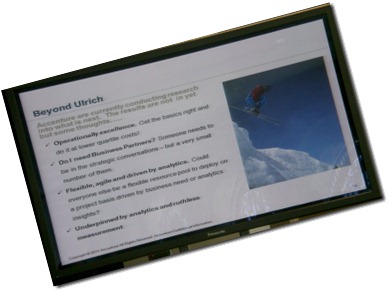
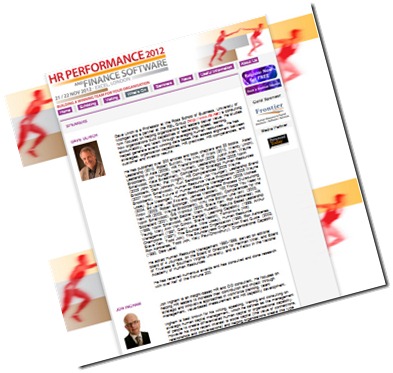
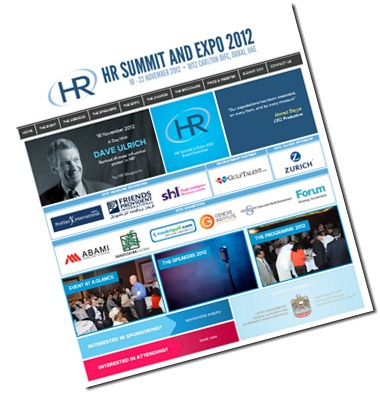
 Less than a month now until the
Less than a month now until the 





